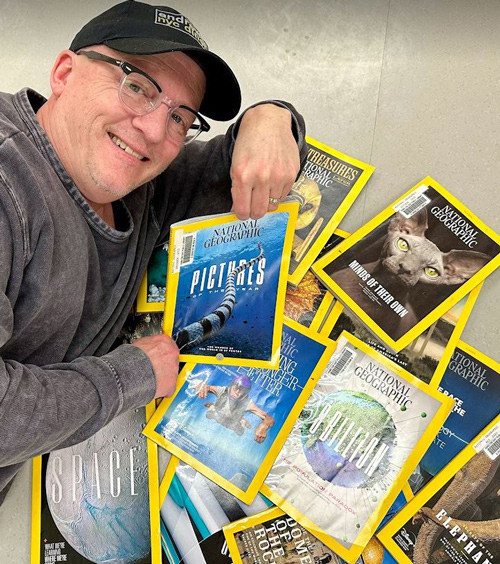Editor’s note: This story by Scott Saalman recently appeared in Next Avenue, a non-profit journalism website produced by Twin Cities PBS.
I recently listened to an NPR news story about how National Geographic, the venerable, glossy-paged gold standard chronicler of our natural world, will no longer be purchasable on newsstands.
This doesn’t mean that the magazine has become an endangered product, unlike the many vanishing species it has reported on over the past decades. A printed monthly version can still be had via subscription. And yes, there is the online version.
At least the magazine is still with us, I thought. Print journalism as we once knew it has undergone drastic change, much to the disappointment of those of us who still bleed black ink.
I have always felt a fondness for Nat Geo, as I refer to the magazine, though to be honest, I cannot recall when I last held an actual copy. Quite possibly it was in the late 1990s when I was married to my first wife, living in our first home. A couple years later, I would lose the house and the magazines in our divorce.
Back then, I discovered several cardboard boxes filled with National Geographic magazines in the attic of my house, presumably saved and forgotten by a previous owner.
After dumping the boxes’ contents onto the floor, I stared at the covers to get an aerial view of a patchwork of the world spread out at my feet: a six-week-old white tigress emitting a playful growl (April 1970); villagers on the Indonesian island of Bali (November 1969); an underwater photographer stalking a rock python, 14 feet long and thick as a man’s thigh (September 1971); an Indian tailor in neck-deep water saving his antique sewing machine from a monsoon flood (December 1984); determined sled dogs battling broken ice during a trek across Arctic America (March 1974); the silhouette of young lovers embracing before the floodlit Arc de Triomphe (June 1960); a right whale breaking surface off the coast of Patagonia (March 1976); Jane Goodall studying the behavior of wild chimpanzees in a Tanzanian jungle (December 1965).
I crawled over the covers, crossing a jumble of yellow borders, and counted 475 issues; the oldest dated January 1949; the most recent dated July 1989.

Photo provided by Scott Saalman
The magazines were a pleasant discovery; for 121 years, at that time, National Geographic had been the undisputed biographer of our world. I couldn’t help but believe that my home’s former owner had bequeathed to me a great responsibility.
Suddenly, I became obsessed with Nat Geo, especially the issues dated before my birth in 1964. There was an excitement to looking at something that, for all practical purposes, was never intended for me to see. I get the same feeling inside museums – or reading other people’s letters. My snoopiness is innate.
Not that National Geographic content is intended to be secretive. It’s just that writers and photographers who sweated over their deadlines probably did so to appease their contemporary public and collect a paycheck – too realistic, probably, to think that the particular crisp issue cradling their work would actually transcend a month’s stay on a coffee table, bypass the trash bin and wind up in the future attics of the yet-to-be-born.
Despite pleas from my then-wife to clean up my mess – likely, she wished I had found a collection of Good Housekeeping instead, thus discovering the wonderful world of neatness – the floor remained cluttered with magazines for weeks. I wasn’t through traveling the world.
The attic discovery turned me into an armchair adventurer. Closing my eyes, I randomly plucked an issue from the floor, returned to my chair, sorted through the pages, and imagined that I was actually jumping over geography to each documented destination.
When I opened my eyes to see the July 1973 issue in my hands, I was transported from my room to Iceland, where I witnessed firsthand how “a volcano’s eerie glow lights doomed houses in an Icelandic village.” (The hellish scene is framed by the trademark yellow border that has decorated the cover since 1910.)
The attic discovery turned me into an armchair adventurer.
Each journey also included spending time in the advertisements. Even the ad space served as a dependable chronicler of a civilization’s progress: our TV sets keep growing (“The new 19-inch G.E. Big as you will ever want it. Super life-size,” claims an ad in the February 1951 issue); our electronic calculators no longer the size of washers and dryers; the back page of the January 1951 issue advertises Hormel Beans and Ham, with this special message at the bottom: “Hear music with the Hormel Girls, Saturday CBS. Sunday NBC.”
Clawing into the meat of July 1973, I went sailing on a yaw among the Ionian Islands of Greece; dodged magma and gas rocketing over an Icelandic fishing port; picked boniato and malanga with Cuban exiles; bathed in a canal with olive-skinned Bangkok women, their hair the color of black licorice; stared at the blood-red underbelly of a Peruvian frog glowing brightly with neurotoxins.
The next issue I blindly picked was the oldest of the bunch, January 1949, which lacks a photo or artwork on its cover (it wasn’t until 1959 that photos and illustrations became a mainstay on the front).
After scrutinizing an ad for a DuMont television with a tiny, fishbowl screen (how in the world did people survive back then?), I flipped through the pages and went from sailing aboard a brigantine that stopped at exotic ports, including Easter Island to look at giant stone faces and Tahiti to lance spiny lobsters in the surf, to touring the Statue of Liberty, gliding aboard an airboat in the Everglades and making violins by hand in Bavaria.
My then-wife asked me what I planned to do with the magazines after I finally explored them all. I told her that I really didn’t have the heart to throw them away. I grew too appreciative of their pages and the gift they offered to our household: the world. I was certain that to trash a Nat Geo was a sin.
Eventually, I refilled the cardboard boxes with all 475 issues and returned them to the attic, paving the way for a future homeowner to eventually discover how the world has been patiently waiting for them.
Back then, this seemed like the right thing to do.
I still think so today – maybe even more so now.
Scott’s new collection of humor columns, Quietly Making Noise, is available on Amazon. He can be reached at scottsaalman@gmail.com.

